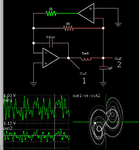Follow along with the video below to see how to install our site as a web app on your home screen.
Note: This feature may not be available in some browsers.

wondering about the parameters A,B and C. Can you kindly show me how to derive them?
Seeing how the equations are printed, it makes me wonder how important the author regards them? The variables run together in a row. I have trouble distinguishing each variable, because some have a subscript, and subscripts ought to be small rather than printed full size.
I guess what I'm saying is that the author seems to give brief mention of parameters A, B, C. I have a hunch they have something to do with ratios of frequencies, or ratios of component values. It's as though their equations are distilled from a combination of the standard formulae for LC resonance and RC time constants and L/R time constants. I do not believe parameters A, B, C were the first steps toward creating the circuit. I think the author first got the oscillator working successfully, then derived a dozen equations from those component values. One or several of those equations may be associated with success. After all these are not the only component values which work in this circuit. Furthermore there are other Chua circuit topologies, which do not necessarily make use of parameters A, B, C.